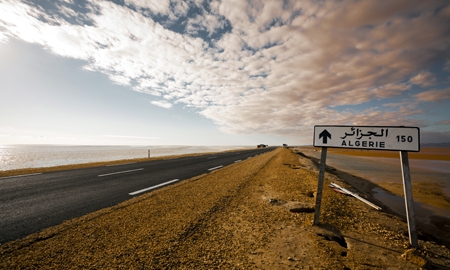Crossing the desert in the northern section of Algeria from Tunisia in the east to the Moroccan border in the west is the East-West Highway, one of the largest public works projects the world has seen.
The six-lane toll road – the longest continuous highway in Africa – forms part of the 7,000-kilometre (4,350-mile) Trans-Maghreb Motorway project, which will link Morocco, Algeria, Tunisia and Libya.
Built by Chinese and Japanese contractors employing an army of construction workers over a period of five years, the hugely ambitious project was described by President Abdelaziz Bouteflika at its launch in 2007 as “the challenge of the century”. Carving the highway across 1,720 kilometres of often difficult terrain in 24 of the country’s 48 provinces and through the cities of Annaba, Constantine, Setif, Algiers, Oran and Tlemcen, has certainly been a project of awesome scale, comprising 60 interchanges and 538 civil engineering structures, including 70 viaducts, 13 tunnels, service stations, truck stops and highway maintenance and operation centres.
Constructing the road to European standards has consumed huge quantities of materials, and involved numerous items of plant and equipment and a largely Algerian workforce of around 20,000 people.
The East-West Highway is just part of a massive ongoing programme, funded by the government from oil revenues, to build the transportation infrastructure the nation needs for economic development.
At the heart of it is the drive to establish a modern and efficient road network linked to ports, airports and railways, connecting the country internally and with its neighbours.
“We strongly believe that entering the global economy will be easier with a fully equipped and structured territory, able to attract investments and stimulate economic activity,” says Amar Ghoul, who until recently was Minister of Public Works.
“All these projects will allow the implementation of a viable, layered and interconnected network that will make Algeria accessible and competitive.”
Public works have been a cornerstone of government policy since President Bouteflika came to office. Major infrastructure projects are part of the government’s strategy to reduce unemployment and poverty, providing work for Algerians and serving as a platform for sustainable development.
The authorities forecast that economic activity generated by the East-West Highway alone, once it is completed, should create at least 100,000 jobs. Meanwhile, construction and the public works sector have been driving growth.
Up to 2014 around $90 billion (£58 billion) is to be spent on new roads, ports and airports. It is part of a long-term plan that includes the construction of 112,696 kilometres of new roads by 2025.
The ongoing five-year phase includes completion of the East-West Highway and links to 830km of secondary and inter-provincial roads, along with the completion of the national dual roads works along 700 km.
The Ministry of Public Works will build more than 2,500km of new roads and rehabilitate around 8,000km of existing roads.
Large projects include completion of the 1,300km High Plateaus Highway, following a trade corridor between the Moroccan border to the west and the Tunisian boarder to the esast; a 350km toll motorway through five inland provinces; and numerous projects to ease city traffic, including completion of the second Algiers ring road.
“There are numerous projects to smooth the flow of traffic in the big urban centres,” says Dr Ghoul. “In addition to the improvement of traffic, great importance has been given to this type of project, for aspects dealing with the improvement of living standards through the designing of open areas and the improvement of the visual aspects of the developments.”
A second phase, from 2015 to 2020, will focus on rehabilitating thousands of kilometres of existing highway, while a third phase will be used to evaluate the finished projects.
In April, Dr Ghoul announced the launch of the Blida-Ghardaia section of another huge project, a major north-south highway linking Algiers and Ain Guezzam, on the border with Niger in the Tamanrasset Province. The first phase will pass through the provinces of Blida, Medea, Djelfa, Laghouat and Ghardaia, and will be difficult as it crosses wadis and mountainous areas.
One of three parallel north-south highways planned for completion by 2030, it will contribute to the opening up of regions that it crosses, especially those located in the central highlands and the south.
The other two highways are planned to run from Oran to Bordj Badji Mokhtar, in southwestern Algeria near the border with Mali, and from Skikda to Djanet on the border with Libya.
The contribution to this vast programme of international companies, such as the China State Construction Engineering Corporation, which is building two thirds of the East-West Highway, is crucial to making the plans a reality. But Dr Ghoul says that working on the project has given Algeria invaluable experience in building roads and bridges in challenging terrain.
“The involvement of foreign companies has strongly contributed to the reinforcement of our realisation capacities and has allowed Algerian companies to acquire viable technology and know-how,” he says. “Joint ventures between Algerian companies and foreign companies are the type of partnerships that we like to encourage.”

0 COMMENTS